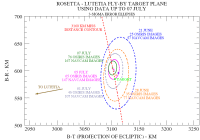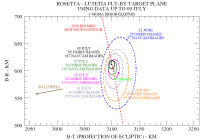No. 141 - Flyby of asteroid (21) Lutetia
See the links in the right-hand menu, under "see also", for the first images of asteroid (21) Lutetia from Rosetta.
Preliminary analysis indicates that spacecraft performance have been nominal throughout the flyby. Detailed analysis will be conducted in the coming weeks in support of the science data processing. The scientific payload worked as planned with only minor anomalies in a few instruments. Preliminary images delivered indicate a very successful data acquisition with very promising scientific results. Operations are now focused on the downlink of all the on-board data, which will take a few weeks.
During the reporting period, mission operations have been conducted with support of the ESA New Norcia (NNO) and Cebreros (CEB) ground stations, and several NASA DSN ground stations (DSS).
The closest approach phase was followed with the 70m dish (DSS-63) at the DSN ground station in Madrid. This allowed the spacecraft to transmit telemetry at the maximum bit rate of 91 kbps. The large dish was also used to amplify as much as possible the signal in support of the radio science investigation (RSI) experiment with the two-way radio link.
| DOY | Date | Pass | Main Activity |
| 186 | 05/07/10 | NNO 2322 | Optical navigation slot 15. Start of science campaign |
| 187 | 06/07/10 | NNO 2323 | Optical navigation slot 16 |
| 188 | 07/07/10 | DSS-24 2324 NNO 2324 |
Optical navigation slot 17 |
| 189 | 08/07/10 | NNO 2325 DSS-65 2326 |
Optical navigation slot 18 |
| 190 | 09/07/10 | DSS-24 2326 NNO 2326 CEB 2327 DSS-26 2327 |
Optical navigation slot 19 |
| 191 | 10/07/10 | NNO 2327 DSS-34 2327 DSS-63 2328 CEB 2328 DSS-24 2328 |
Verification of NAVCAM tracking Back-up to NNO Closest approach operations Back-up to DSS-63 Asteroid flyby data downlink |
|
DOY = Day of year | |||
At the end of the reporting period (DOY 191) Rosetta was at 454 million km from Earth (3.03 AU) and the one-way signal travel time was 1521 seconds (25 minutes and 21 seconds). The distance to the Sun was 406.12 million km (2.71 AU). Rosetta's distance to asteroid Lutetia at closest approach was 3160 kilometres.
Optical Navigation Campaign
On 10 July Rosetta successfully performed its flyby of asteroid (21) Lutetia. In the final weeks leading up to the flyby, in addition to the spacecraft tracking and usage of radiometric data for navigation purposes, Rosetta's on-board cameras were used to visually track the asteroid in an optical navigation campaign. The observations were fed into the orbit determination process to refine Lutetia's predicted location and to optimise Rosetta's trajectory for the flyby.
The three cameras that were used for these observations were Rosetta's two navigation cameras (NAVCAM A and B) and the narrow angle camera (NAC) of the OSIRIS instrument.
A series of 19 time slots had been allocated for the optical navigation campaign. The first slot was on Monday 31 May, followed by two slots every week in the following three weeks (on 7, 9, 14, 16, 21 and 23 June), and finally 12 daily slots between 28 June and 9 July.
During the optical navigation campaign NAVCAM A and B, as well as OSIRIS-NAC were permanently ON.
Final navigation status
The optical navigation campaign leading up to the asteroid flyby was successfully completed in this reporting period. A total of 272 images, acquired by the spacecraft cameras between 31 May and 9 July, were used to determine the spacecraft and the asteroid relative trajectories.
Only the first of the five available slots for trajectory correction manoeuvres (TCMs) was used to adjust Rosetta's trajectory, on 18 June, 3 weeks before the encounter (see also Rosetta Status Report no. 138). The last orbit determination before the encounter showed a nominal miss distance (3160 km) with a negligible error (about 0.1°) on the target plane of the flyby.
Below are the last two plots of the navigation campaign showing the evolution of the predicted situation in the target plane of the Rosetta - Lutetia flyby. They show the progressively more accurate predictions based on data up to 7 July and 9 July 2010. From the final prediction on 9 July, closest approach to the asteroid was expected on 10 July 2010 at 15:44:57.25 UTC.
The target point for Rosetta's projected position in these plots is marked green. The error ellipses for Rosetta's predicted position become narrower as more data from the navigation campaign is included.
The red curve in these plots corresponds to a miss distance of 3160 km from Lutetia. This was the minimum allowed flyby distance for Rosetta. If the spacecraft would have passed closer to Lutetia the asteroid would have filled up the entire field of view of Rosetta's cameras during closest approach. This would have impacted the spacecraft's attitude control (the images guide the attitude control system) and also the scientific observations which were prepared to be performed from within a pre-set distance from the asteroid.
Flyby of asteroid (21) Lutetia
The second and last asteroid flyby of the Rosetta mission was conducted as planned on 10 July 2010. The spacecraft went through the delicate mission phase without any problem and all of the planned operations were executed.
About four hours before closest approach, the spacecraft performed a flip manoeuvre to acquire the correct attitude before the flyby and the spacecraft was readied to enter Asteroid Flyby Mode (AFM).
During this mode, the attitude of the spacecraft was automatically driven by one of the navigation cameras to continuously keep asteroid (21) Lutetia in the field of view of the imaging instruments as the spacecraft passes Lutetia at a relative speed of 15 km/s. After a careful performance check it was decided to use NAVCAM A for this closed-loop tracking of the asteroid.
The entry in closed-loop tracking was performed at the latest planned time (1 hour before closest approach). This was done to minimise the effect of the small disturbances of charged particles hitting the NAVCAM CCD. The camera stopped detecting pixels above the selected threshold about eight minutes after closest approach (at 15:52:41 UTC).
Preliminary analysis of the data show nominal performance of the navigation cameras throughout the flyby phase. During the asteroid tracking Saturn transited in the NAVCAM field of view for about 10 minutes, without disturbing the attitude control.
Timeline of the key events during the flyby:
|
Time (UTC) |
Event |
| 03:33:00 | Beginning of tracking with New Norcia |
| 06:00:00 | Final check of NAVCAM asteroid tracking |
| 08:30:00 | GO for asteroid flyby mode (AFM) and uplink of telecommands |
| 11:05:00 | Beginning of tracking with DSS-63 (Madrid) |
| 11:24:55 | Start spacecraft flip manoeuvre |
| 12:04:55 | End spacecraft flip manoeuvre |
| 14:44:55 | Start of closed-loop asteroid tracking with NAVCAM A; autonomous attitude control |
| 15:39:55 | Stop of radio communications via high-gain antenna (HGA) - Loss of telemetry signal (earliest) |
| 15:44:57 | Closest approach to Lutetia (3160 km) |
| 15:45:55 | Inhibition of NAVCAM measurement for asteroid tracking (Sun blinding) |
| 16:04:55 | End of closed-loop asteroid tracking and autonomous attitude control |
| 16:19:55 | Resumed communications via HGA - Acquisition of telemetry signal |
| 17:40:37 | Start of science data downlink |
| 21:55:00 | End of tracking with DSS-63 (Madrid) |
Spacecraft
Payload
ALICE
The instrument was operated during the asteroid flyby and will complete its operations in the coming days.
CONSERT
The instrument is currently OFF.
COSIMA
The instrument was operated during the asteroid flyby and will complete its operations in the coming days.
GIADA
The instrument is currently OFF.
MIDAS
The instrument was operated during the asteroid flyby and will complete its operations in the coming days.
MIRO
The instrument was operated during the asteroid flyby and will complete its operations in the coming days.
OSIRIS
Since 2 June 2010 (DOY 153) the instrument has been ON, with the narrow-angle camera (NAC) taking images of asteroid Lutetia as part of the optical navigation campaign. During the flyby OSIRIS was active as part of the scientific operations and the images of the asteroid delivered so far are spectacular.
ROSINA
The instrument was operated during the asteroid flyby as part of the scientific operations.
RPC
The instrument was operated throughout the flyby.
RSI
The ultra-stable oscillator (USO) is ON/muted since DOY 032/2010. The RSI team will use the two-way radiometric data acquired during the closest approach phase with a 70-metre ground station radio dish to estimate the mass and the density of the asteroid (21) Lutetia, thus answering one of the most intriguing scientific questions.
VIRTIS
The instrument was operated flawlessly during the flyby and is currently OFF.
LANDER Philae
The instrument was operated flawlessly during the flyby and is currently OFF.
SREM
The instrument is ON with standard settings since DOY 032/2010.
Future Milestones
The peak phase of the Lutetia flyby operations is now over and the mission will continue with the science data downlink phase for the next few weeks. After this the mission operations will focus on the preparation of the deep space phase.
For most of the remainder of its passive cruise towards its final destination, comet 67P/Churyumov-Gerasimenko, Rosetta will be configured in deep space hibernation, from July 2011 to January 2014. Two major trajectory manoeuvres are planned right before and after the deep space hibernation. These will synchronize Rosetta's orbit with that of the comet the leading up to the spacecraft's rendezvous with the comet in May 2014.
---
Legal disclaimer
This report is based on the ESOC mission operations report, WOR #141. Please see the copyright section of the legal disclaimer (bottom of this page) for terms of use.



